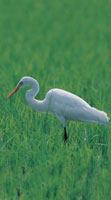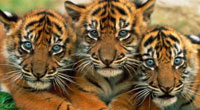 For
all one's inclination to believe that Rajasthan is a desert. It is difficult to
ignore the fact that the region, in fact, has a varied topography, and includes
from semi-arid, desert-like conditions to among the oldest mountains in the
world, and lush, water-filled valleys. No wonder too that its wildlife is so
rich in variety, including from the tiger and leopard to endless varieties of
deer, rhesus monkeys, reptiles including the python, and a profusion of
bird-life that includes water-birds.
For
all one's inclination to believe that Rajasthan is a desert. It is difficult to
ignore the fact that the region, in fact, has a varied topography, and includes
from semi-arid, desert-like conditions to among the oldest mountains in the
world, and lush, water-filled valleys. No wonder too that its wildlife is so
rich in variety, including from the tiger and leopard to endless varieties of
deer, rhesus monkeys, reptiles including the python, and a profusion of
bird-life that includes water-birds.
The Thar Desert, also referred to as the Great Indian Desert, fall for part within the state, though parts of it do stretch into other states such as Gujarat, Punjab and Haryana, and this is what gives Rajasthan its unique topographical character. Unlike the typical desert it does not have oasis, palms or cacti, and is densely populated. Sand dunes characterize it, just as much as saline depressions and lakes.
 Another distinguishing natural feature is Rajasthan is the
Aravalli mountain chain, often referred to as hills because the height is
rarely beyond a thousand metres. The folds of the Aravallis were used
successfully by the Rajput princes to establish their citadels, but the
mountains are among the oldest in the world. Since the Aravallis tended to be
heavily forested, they became a natural refuge for birds and animals. Even
though human degradation of the environment has led to deforestation, in areas
where the forests are still thick, the reserves continue to offer sanctuary to
their original, resident and migrant species.
Another distinguishing natural feature is Rajasthan is the
Aravalli mountain chain, often referred to as hills because the height is
rarely beyond a thousand metres. The folds of the Aravallis were used
successfully by the Rajput princes to establish their citadels, but the
mountains are among the oldest in the world. Since the Aravallis tended to be
heavily forested, they became a natural refuge for birds and animals. Even
though human degradation of the environment has led to deforestation, in areas
where the forests are still thick, the reserves continue to offer sanctuary to
their original, resident and migrant species.
MAJOR NATIONAL PARKS & SANCTUARIES OF RAJASTHAN -
-
Keoladeo Ghana National Park
-
Ranthambhore National Park
-
Sariska Tiger Reserve
Other Sanctuaries - Rajasthan has a large number of sanctuaries that are smaller, more inaccessible or less well known than its more popular counterparts. Some of these are listed below.
BHENSRODGARH - Close to Kota (53 km), it
consists of scrub and dry deciduous forest and is home to leopard, sloth bear
and chinkara.
DARRAH - Once the hunting preserve for the royal family of
Kota, this sanctuary, 50km from Kota, is home to sloth bears, chinkaras, the
leopard and the wolf.
JAISAMAND: Located on the fringes of a vast man-made lake of
the same name, the small sanctuary is picturesque and houses leopard, wild boar
and a variety of deer, while its waters are home to population of crocodiles,
50km from Udaipur.
KUMBALGARH - A large sanctuary in the Aravallis, 120 km from
Udaipur, it has a formidable collection of wildlife that includes leopards and
sloth bear, a variety of deer including the chousinga of four-horned antelope,
and the ratel as well as the flying squirrel."
MOUNT ABU SANCTUARY - Located on fringes of the town of the same
name, this small sanctuary is thickly forested. Wildlife includes leopard,
chinkara, sloth bear, sambhar and wild boar. The slopes of the hills provide
some of the state's most interesting topography, especially since the height of
this hill station keeps it cool even in the summer months.
CHAMBAL - Just beyond Kota, along the banks of the river
Chambal all the way to its confluence with the Jamuna, this is where the waters
are rich with gharial, crocodiles for which it is breeding centre. Other
wildlife includes caracal, wolf, blackbuck and chinkara.
SITAMATA - In forests of bamboo and dry deciduous vegetation,
108 km from Udaipur, this forested sanctuary provides rich foraging pastures
for a variety of deer that include the chousinga, and for caracal, wild boar,
pangolin and leopard.
TALCHAPPAR - A very small sanctuary, 210 km from Jaipur and in
the Shekhawati region, this is home to a large population of graceful
blackbuck. Desert fox and desert cat can also be spotted along with typical
avifauna such as partridge and sand grouse.
BHENSRODGARH - Close to Kota (53 km), it
consists of scrub and dry deciduous forest and is home to leopard, sloth bear
and chinkara.
DARRAH - Once the hunting preserve for the royal family of
Kota, this sanctuary, 50km from Kota, is home to sloth bears, chinkaras, the
leopard and the wolf.
JAISAMAND: Located on the fringes of a vast man-made lake of
the same name, the small sanctuary is picturesque and houses leopard, wild boar
and a variety of deer, while its waters are home to population of crocodiles,
50km from Udaipur.
KUMBALGARH - A large sanctuary in the Aravallis, 120 km from
Udaipur, it has a formidable collection of wildlife that includes leopards and
sloth bear, a variety of deer including the chousinga of four-horned antelope,
and the ratel as well as the flying squirrel."
MOUNT ABU SANCTUARY - Located on fringes of the town of the same
name, this small sanctuary is thickly forested. Wildlife includes leopard,
chinkara, sloth bear, sambhar and wild boar. The slopes of the hills provide
some of the state's most interesting topography, especially since the height of
this hill station keeps it cool even in the summer months.
CHAMBAL - Just beyond Kota, along the banks of the river
Chambal all the way to its confluence with the Jamuna, this is where the waters
are rich with gharial, crocodiles for which it is breeding centre. Other
wildlife includes caracal, wolf, blackbuck and chinkara.
SITAMATA - In forests of bamboo and dry deciduous vegetation,
108 km from Udaipur, this forested sanctuary provides rich foraging pastures
for a variety of deer that include the chousinga, and for caracal, wild boar,
pangolin and leopard.
TALCHAPPAR - A very small sanctuary, 210 km from Jaipur and in
the Shekhawati region, this is home to a large population of graceful
blackbuck. Desert fox and desert cat can also be spotted along with typical
avifauna such as partridge and sand grouse.